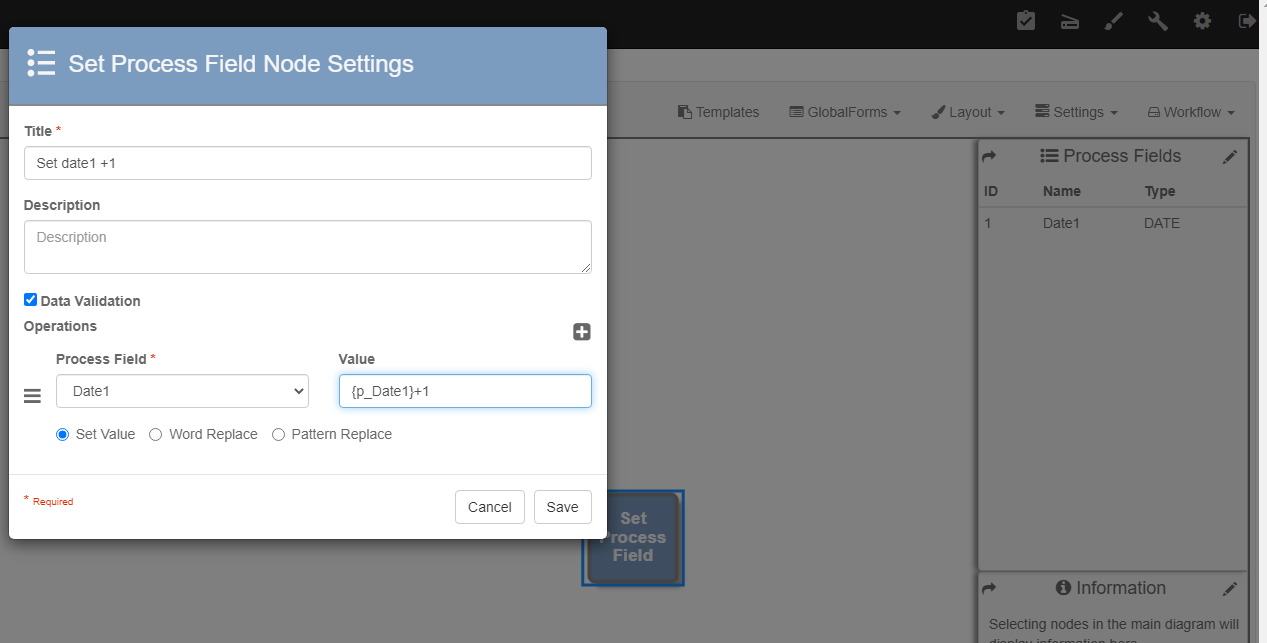
S9 Notation is a tool for embedding variables into Annotations, Workflow Nodes fields, and email notifications. These notations are replaced at run-time by Field values. To see a list of notations available for a Field, type in a single brace ( { ).
Every GlobalAction & GlobalCapture Workflow comes with a set of standard S9 Notations that be used as follows:
| Formatting | Result |
|---|---|
{LASTUSERMODIFIED} | Contains the last user to either scan or validate the process |
{PROCESSID} | Contains the numeric unique identifier for this particular process |
| {NOW} | Contains the date and time that the notation is accessed |
{TODAY} | Contains the date that the notation is accessed |
{p_ActiveTemplate} | The Template which was lasted assigned to the document through classification |
{p_BatchID} | Contains the numeric unique identifier for this particular set of processes |
{p_FileType} | Contains the current file extension of the document that is being processed |
{p_FilePath} | Contains the path to the document in process if merged. (PDF and TIFs do not populate this property mid-process) |
{p_OriginalFileName} | Contains the original name of the file prior to it being imported into the GlobalCapture Workflow |
{p_ReleasedFilePath} | Contains the path to the released document following a Release Node |
{DOCUMENTLINK} | Contains a local document link path. Used in Global Action for documents that already exist inside of the archive. |
When simply referencing the value currently within a Process Field, the following S9 Notation can be used. (Replace ProcessFieldName with the name of your Field.)

It is helpful to keep in mind that there can be data-type mismatch issue spawned from inserting one Process Field into another. For example, an alpha-character value cannot be placed within a numeric or decimal Field.
In GlobalCapture Convey PLUS, you can extract the confidence of a given Field that has passed through the Classify Node or has been modified by a user. This will return a numeric value between 0 and 100; a higher value meaning that the capture engine is more confident in the value currently held in the Process Field.

You can access specific indexes of data from within a Multi-Value Field using S9 Notation. In the example, an index of 0 is provided within the MVFieldName notation to extract the first value of the array of data. (Replace MVFieldName with the name of your Multi-Value Field.) Note that if it attempts to access an index that does not exist, it will error in the Batch Manager.

In a slightly more complex example of a basic S9 Notation within a MVFieldName notation, the value extracted from the MVFieldName array will be based on the numeric value currently stored within the index Process Field.

With a method of extracting specific values from the MVFieldName notation, it can become useful to check the length of the Field data to ensure that a valid extraction is taking place. Use a trailing underscore followed by length to access the exact number of values within the Multi-Value Field.

Like normal Process Fields, the MVFieldName notation supports confidence extraction.

You can use S9 Notation with your Table Fields to access row and column data during your Workflows. The example shows how to access a specific value from within a Table Field. (Replace TFName with the name of your Table Field.) Note that there are two indexes used as coordinates of this data. The first index is the Field ID of the Process Field within that Table Field. This points to the column from which are you are planning on extracting data. The second is the index of the array holding the data. In this example, the Process Field with Field ID 5 and 0 to extract data in the first row of the Table Field.

Like with MVFieldName notation, use a trailing underscore followed by length to access the exact number of values within the Table Field. This example attempts to see how many rows are in the column for Fields with Field ID 5.

Here is the more complex example to show what S9 Notations are capable of. This example attempts to extract the confidence of a particular value in the Table Field. To focus on this value, it attempts a mathematical operation within the second index of the Table Field. This operation is checking the length of the Table Field column and then subtracting a counter from it to specify the index. This index is then used to extract the confidence from that specific table cell.

You can use addition and subtraction in S9 Notation-based operations, as seen in the following examples.


The values that are needed to do math do not need to be S9 Notations, but at least one of the values included in the string does.
You can find the sum and the average in Multi-Value Field and Table Field columns. The Multi-Value Field (MVFieldName) or Table Field (TablefieldName) columns needs to contain numeric or decimal data.


You can use {TODAY}+1 or {TODAY}-1 if you would like conditionally check a date field. This might be useful if you have a workflow that needs to sort old documents such as {TODAY}-30.
On a set process field node you can perform date math such as {p_Date1}+1 . In this example I'm using a date type field and adding 1 day to it. You can also add 10, 30, 100, etc. The name of my field is Date1. This allows you to add a later date to an incoming document.
